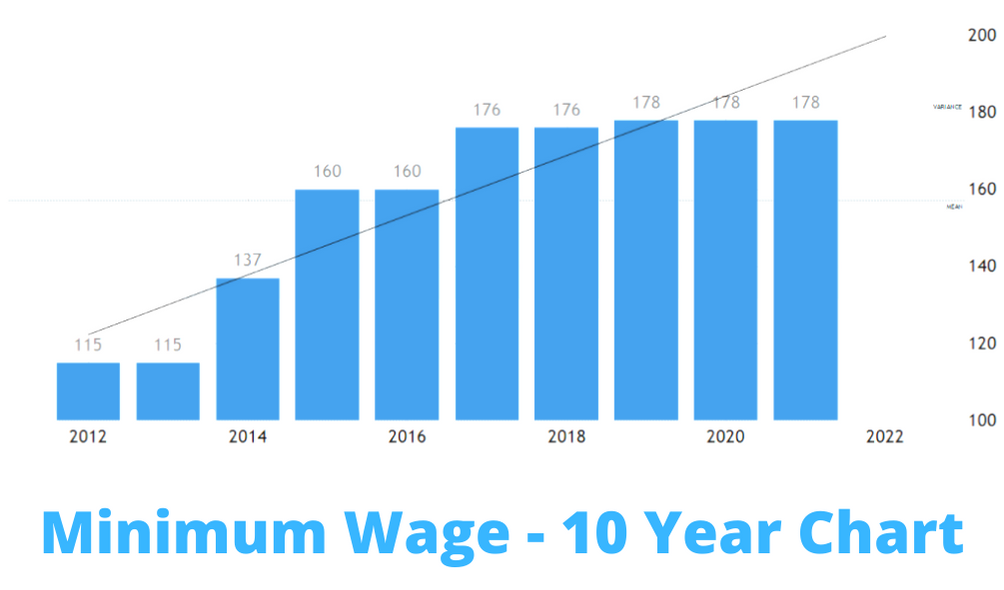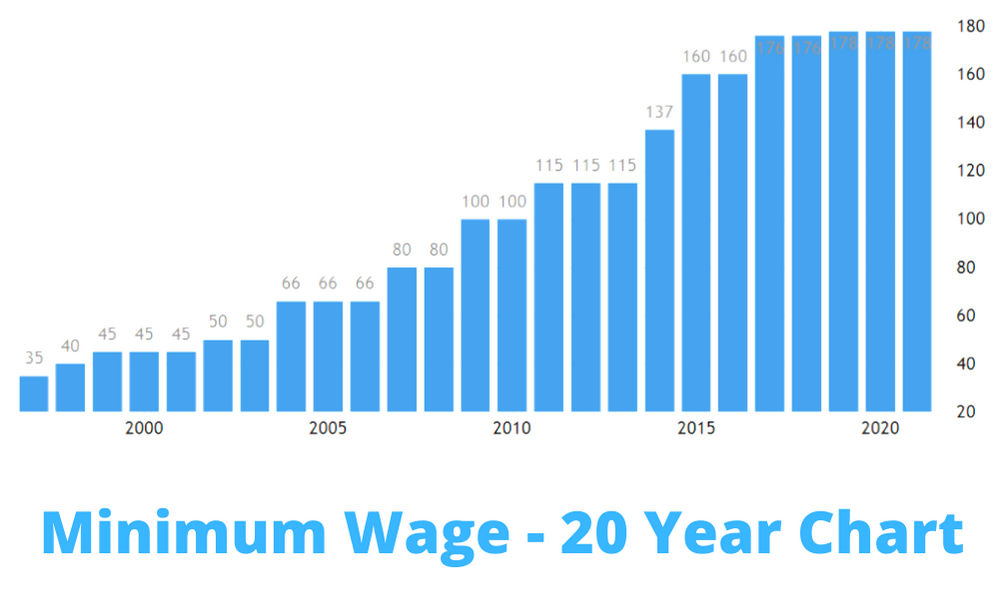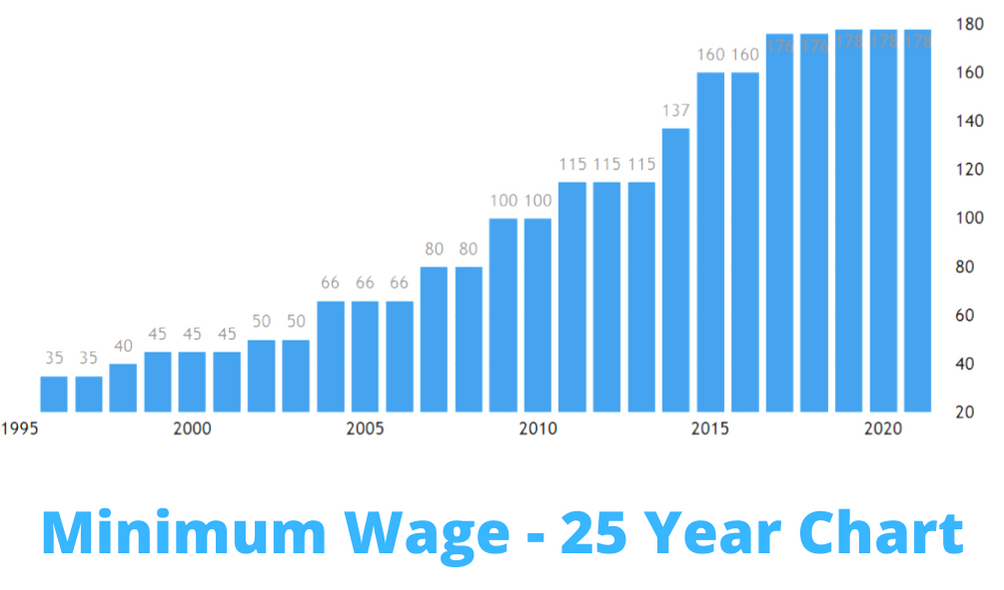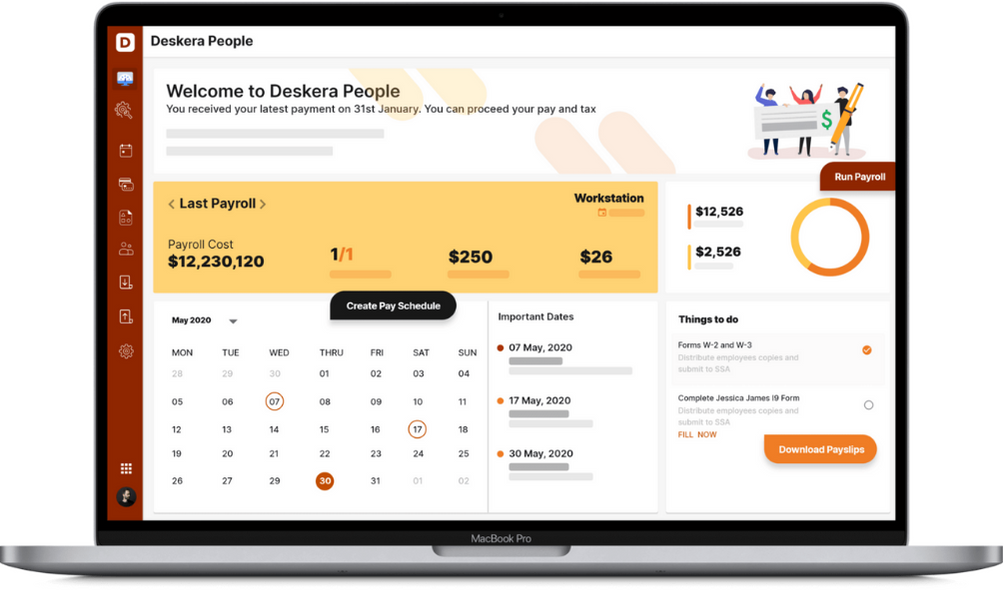The pandemic has been devastating for many. With poor and working-class people receiving only the daily wages as their livelihood, the decision was taken by keeping their interests in mind.
Because of this, there has been an increase in the minimum wage in Delhi and the daily wages have been increased.
New minimum wages in Delhi have been proposed for all contract workers by the Delhi government. Private firms will see a 53% increase in their non-permanent employees' salaries, while state government employers will see an 11% increase.
This article will take you through all you needed to know about the Minimum wages in Delhi. We have also covered a bit of the history of the minimum wages here.
Here’s what more you will learn:
- What is the Minimum Wage?
- Significance of Minimum Wage
- History of Minimum Wage
- Difference Between Previous Laws and Code on Wages
- What is India National Level Floor Minimum Wage?
- Minimum Wage in 2022
- Minimum Wage in Delhi
- Changes in Wage in Last Two Years
- Table for Minimum Wage
- Employee Management
- Payroll Management

What is the Minimum Wage?
Minimum wages can be defined as the lowest amount of remuneration that the employers have to pay to their workers or wage earners for the work done in a specific time frame, which an individual contract or collective agreement cannot reduce.
A competent authority, law, wage council, tribunals, or labor courts can determine the minimum wage. Introducing the minimum wage aims to protect the workers from unfair and excessively low wages.
As a result, everyone gets a fair share of the progress and growth happening in the industry. Besides, this also ensures that a minimum wage for living is guaranteed to all who are employed and need it.
By promoting minimum wages, workers will be able to overcome poverty to a certain degree and eliminate unfairness. Overcoming inequality also includes overcoming the inequality between men and women when there is a pay disparity for the same amount of work done.
As a result, minimum wage policies complement and strengthen employment and social policies. Income and labor market inequality can be addressed in several ways.
Policies that promote employment, social transfers, and conducive environments for sustainable businesses are all a part of this.
Significance of Minimum Wage
There is also a difference between minimum wages, which set a floor, and collective bargaining, which sets the wages above existing levels. We shall understand this through a figure that hypothetically describes the importance of minimum wage:
The image depicts the wage distribution of 20 employees before the introduction of the minimum wage. It has several workers on the Y-axis or vertical and the Wage level on the X-axis or the horizontal axis. It also shows a minimum wage zone and a collective bargaining zone. Both terms can be utilized to create the minimum standards and establish wages above an existing floor.
We can see how a small section receives a very small wage on the extreme left. The yellow circle highlights this minimum wage zone in which the wage-earners receive a meager amount as their wage. The minimum wage targets this yellow zone and to combat the unduly paid or the lowest-paid employees, to remove unfairness regarding payment.
The pink circle illustrates the collective bargaining zone which can be utilized to determine the wage above the existing floor. This graph helps us understand why we need to have minimum wage and how it the minimum wage helps battle poverty and pay discord.
History of Minimum Wage
Let’s get a chronological view of how the minimum wage has progressed over the years and across the globe:
1894
It was in 1894 in New Zealand that the first national minimum wage laws were passed. It was the Industrial Conciliation and Arbitration Act. This act imposed compulsory arbitration for wage negotiations with unions.
1907
Following this, Australia rendered the Harvester decision in 1907.
1917
This soon resulted in the Federal Constitution of Mexico including a minimum wage clause in 1917. It was the first constitutional provision in the world to recognize explicitly that the State is responsible for ensuring minimum living standards.
1933
The result of this was the creation of the National Minimum Wage Board in 1933 to establish general minimum wages for all workers across the nation.
1943-India
Indian workers, however, did not benefit from replicating these global developments. Yet, Article 43 of the Indian Constitution acknowledges the government’s responsibility for creating an environment in which all citizens can find employment and receive a "fair wage".
An investigation committee was established in 1943 by the Indian Labour Conference and the Standing Labour Committee to investigate working conditions and minimum wages.
1946
As early as 1946, the Standing Labour Committee proposed legislation exclusively dealing with the minimum wage issue defined three wage levels:
1. Living wage
2. Fair Wage
3. Minimum Wage
1948
In addition to basic needs like health care and shelter, the minimum wage was designed to enable individuals to pay for these other necessities. The result was the Minimum Wages Act 1948. A detailed procedure for determining minimum wages was outlined in the Act. It was the duty of the appropriate governments i.e. the Central and State governments.
The considerations were based on the different scheduled employments (skilled and unskilled labour, agricultural and nonagricultural employments, and other industries). It became mandatory for all employers to abide by the minimum wage rate fixed by the government.
1991
Then came the National Floor Level Commission in 1991 with the idea of reducing the disparity between the wages. However, the National Floor Level Minimum Wage is not a statutory measure.
2019
In August 2019, the Code on Wages was enacted. This new legislation replaces the Minimum Wages Act, as well as other wage-related laws, such as Payment of Wages Act, 1936; Minimum Wages Act, 1948; Payment of Bonus Act, 1965; and Equal Remuneration Act, 1976.
Difference between Previous Laws and Code on Wages
Prior to the Code on Wages, provisions related to minimum wages were only applicable to establishments included in the Schedule under the Act. However, now they apply to all employees irrespective of their employment sector. As a result of the code, wages include basic pay, dearness allowance, and retaining allowance, but do not include HRA, bonuses, etc. In the case where the specified exclusions exceed 50% of the total salary, the excess will be included in wages.
Minimum Wage Trends for the Past 25 Years
From 1996 to 2021, the minimum wage in India averaged 99.65 INR/day. 178 INR/Day was the all-time high in 2019 and 35 INR/Day was the record low in 1997.
Following are the tables from which we can learn about the minimum wage trends for the past 25 years.



What is India National Floor Level Minimum Wage (NFLMW)?
The National Floor Level Minimum Wage was introduced in 1996 by the central government. A National Floor Level Minimum Wage is the lowest wage below which a state government cannot fix the minimum wage.
Determined in 2019, NFLMW is Rs. 178 per day.
Minimum Wage in 2022
The Indian National Floor Level Minimum Wage in 2022 is expected to be 190.00 INR/Day. The cost of living index helps modify and revise the minimum wage rates. The wages can be set for an entire state, part of the state, class, or class and employment pertaining to these categories.
Minimum Wage in Delhi and Table for Minimum Wage
The minimum wage came into effect on October 1, 2021. Here is the updated list of the minimum wage in Delhi:
What Does the Order State?
The order on the Delhi minimum wages was revised by the Delhi government by passing an order. Here are the details of the order:
- The Government of the National Capital Territory of Delhi revised the minimum wages under the minimum wages 12(142)/02/MW/VII/3636 dated 22/10/2019 in Schedule Employment.
- The notification says that the Dearness Allowance will be payable based on the average index numbers of a six-monthly basis, i.e. of January to June and July to December, on 1st April and 1st October respectively.
- The National Capital Territory of Delhi has adjusted the average All India Consumer Price Index Number of the duration from January 2021 to June 2021. The adjustment has led to an increase of 4.26 points which is the Dearness Allowance which will be paid towards all categories with effect from 1/10/2021.
What Does the Order Mean?
Many of the workers or employees may want to learn about their minimum wages or the minimum salary in Delhi's private sector. The order states that from October 1, 2021, no worker shall be given a salary lesser than that stated in the table above.
The workers can tally their salary slip with the Basic+DA mentioned in the table.
Minimum Wage - Public Grievances
The Ministry of Labour and Employment or MOLE is among the top 20 ministries that receive the most grievances. A Government of India portal, Department of Administrative Reforms and Public Grievances provides citizens with a platform to redress their grievances. The website http://pgportal.gov.in/ can be used to lodge grievances against the Ministry of Labour & Employment.
There are mainly two ways by which the Ministry receives public grievances, online through the mentioned CPGRAMS Portal and in person or by mail.
Changes in Minimum Wage in the Last Two Years
We have already seen the updated list of the minimum wages in Delhi applicable from October 2021.
Let us now look at the variation in the minimum wage that has taken place in the last two years. That is, the tables following will depict the rates applicable from 1/10/2019 and 1/10/2020.
The government rules need to be adhered to in the calculation of the amount payable to the employees. Payroll should be added to the payroll process in India when processing payments to employees.
The payment applies to a working duty of 8 hours. Overtime payment is according to the rules.
In India, the enhancement in wages for workers will be shown in the basic plus deferred allowance column (Basic+DA). The payment to the workers will be provided once other components have been taken into consideration, such as taxes, bonuses, allowances, arrears, TDS, deductions, etc.
Employee Management
Employee management is an essential and integral part of any organization. Fundamentally, it is all about making efforts to bring out the best in an employee and help them work in a way that they can achieve the larger objectives of the company.
There are many elements on which employee management is largely based:
Select
It is about selecting the appropriate candidate based on their skill set and the company's requirement.
Monitor
This includes estimating the employee’s performance.
Interactive engagement
This basically includes the daily interaction or the communication between the employees, manager, peers to gain business insights, discuss work culture, feedback, etc.
Reward
This aspect includes the appreciation, the praise, and the rewards that an employee is entitled to receive attributed to their excellent performance.
Integrity
This is about the discipline that the employees must maintain in order to accomplish higher grounds for the company. Also, the managers may introduce measures to enhance performance.
Using software like Deskera People can help you across the various aspects related to employee management. From adding employee details to attendance and leave management, Deskera makes employee management easy for your business.
Payroll Management
You can streamline and centralize your organization's salary payments with a Payroll Management software. In a nutshell, the program calculates salaries, tax deductions, incentives, and bonuses on its own, handles payments and deductions, and records them in its database digitally.
Deskera Payroll
Payroll management and employee management are integral to any organization. If you are looking for a holistic and automated tool to manage payroll, employees, expenses, contractor management, Deskera People could be the apt solution.
Process your payroll now with Deskera People:

Key Takeaways
Here are the important takeaways from the article:
- New minimum wages in Delhi have been proposed for all contract workers by the Delhi government. Private firms will see a 53% increase in their non-permanent employees' salaries, while state government employers will see an 11% increase
- Minimum wages can be defined as the lowest amount of remuneration that the employers have to pay to their workers or wage earners for the work done in a specific time frame, and which cannot be reduced by an individual contract or collective agreement
- By promoting minimum wages, workers will be able to overcome poverty to a certain degree and eliminate unfairness
- From 1996 to 2021, the minimum wage in India averaged 99.65 INR/day
- 178 INR/Day was the all-time high in 2019 and 35 INR/Day was the record low which was in 1997
- National Floor Level Minimum Wage (NFLMW) is the lowest wage below which a state government cannot fix the minimum wage
- The Indian National Floor Level Minimum Wage in 2022 is expected to be 190.00 INR/Day
- The website http://pgportal.gov.in/ can be used to lodge grievances against the Ministry of Labour & Employment
Related Articles













